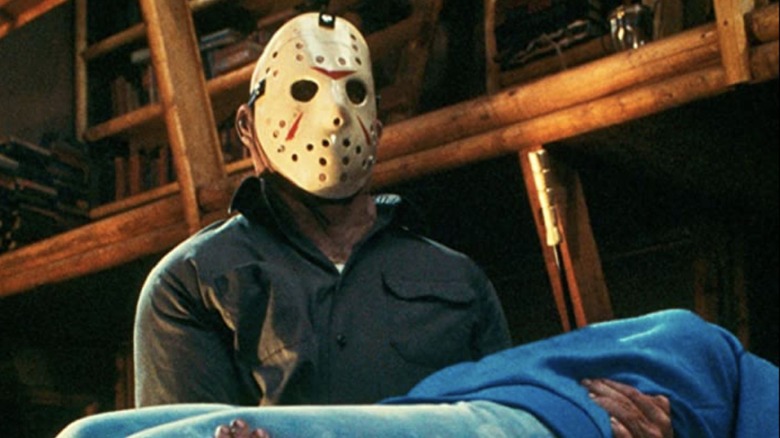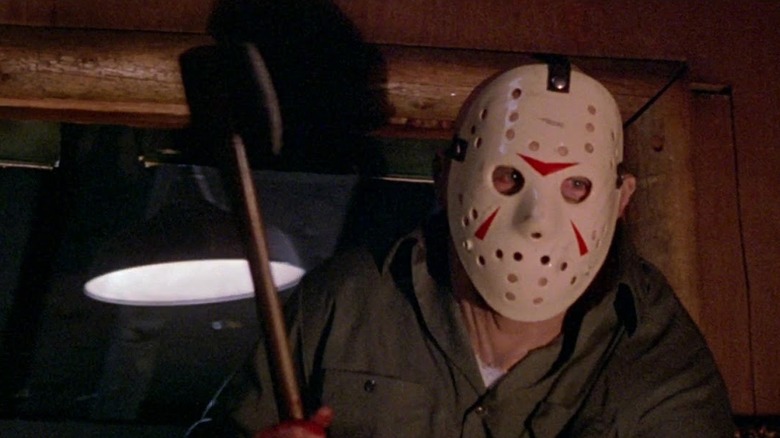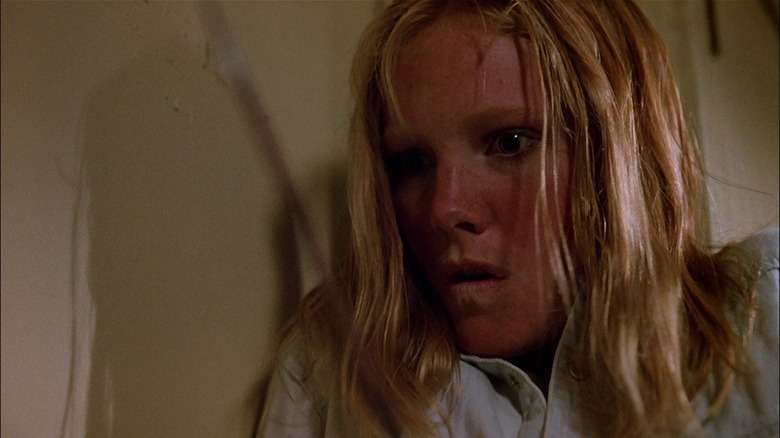Friday The 13th Part 3 Could Have Been A More 'Psychological' Turn For The Series
Fans of Jason Voorhees already know the trivia: Steve Miner's sequel "Friday the 13th Part 3 3-D" was the first film in the notorious slasher series to feature the central serial killer wearing his recognizable hockey mask. Some of Jason's more well-researched fans might also know that the mask was molded from the facial accessory worn by the Detroit Red Wings in the 1950s. That information reveals a missed opportunity: The series mostly takes place around Camp Crystal Lake, New Jersey. "Part 3" was released in August of '82. The New Jersey Devils were formed in June of that same year. The filmmakers missed their chance to depict a Jersey boy like Jason sporting a Devils mask. Now he will always be stanning for Detroit. What a waste.
In David Grove's 2005 book "Making Friday the 13th: The Legend of Camp Blood," series producer Sean Cunningham openly admitted that the original 1980 "Friday" film was intended to be every bit a knock-off of John Carpenter's ultra-successful "Halloween" from two years earlier. Cunningham, who also directed the original, also copped to imitating some of Carpenter's style in at least one DVD commentary track. The original "Friday" played more like a campfire story: Is the mysterious killer in the woods actually the ghost of the boy who drowned here years ago? It turned out to be that boy's mother. In "Friday the 13th Part 2," against all logic, Jason is revealed to have been alive this whole time, and actually is stalking around (with a bag over his head) killing more camp counselors for sport/revenge/punishment for their vices.
But the third movie, it seems, was originally conceived as a departure from the old stalk-and-kill formula. According to a 1982 issue of Fangoria, "Part 3" was going to be more of a psychological study.
Sticking to the formula
In the Fangoria article, Steve Miner, who directed "Part 2" and "Part 3," recalls a time when the third film was intended to be a departure from the first two movies. Slasher films, as modern audience have come to know them, were invented only a few years previous with films like "Black Christmas" and "Halloween," and many filmmakers had already found a great deal of success in adhering to a certain formula: Merely gather multiple young people in a remote location for purposes of sex and debauchery, strip them out of their clothes, and then have a masked killer murder them with a blunt object or bladed construction tool. The protagonist of your film is a mute killer who wears a mask, so expensive "star power" is not needed. And, since the murder victims will likely not come to define the series, your actors only need to be willing to work for cheap. Find a low-budget location and a lot of stage blood, and bang — you've got a movie.
Miner recalls toying with the idea of setting "Friday the 13th Part 3" out of that formula before coming to an agreement that slasher mayhem was what audiences had come to expect, and should be the correct path forward. Miner was specifically asked if there was discussion on an alternate script, to which Miner answered:
"Quite a bit. I spent a lot of time developing a number of different storylines and approaches that would be a breakaway from the other films. Finally, we all decided that it would have been a mistake. We have a certain audience that enjoyed 'Friday the 13th,' and we owe them the best possible film that they will enjoy; Suspense and scares within the format we'd already established."
But that wasn't always the case.
Friday the 13th: Ginny Gets Help
Part of many slasher films is a trope come to be known as the Final Girl. At the end of many slashers, only one character will remain alive to confront the killer once and for all. That character was typically a young woman, and many, many essays and books (and even a few well-written lists) have been penned as to what the character represents and what the trope has come to mean. The Final Girl in "Friday the 13th Part 2" was a character named Ginny, played by Amy Steel from "Guiding Light." At the end of "Part 2," Ginny, upon finding Jason's woodsy lair, posed as Jason's mother in an effort to distract him. It works well enough for her to slice a machete into his shoulder. The film's epilogue implied that she would be haunted by the events of the film forever.
Miner wanted to continue Ginny's story. What would a victim experience after surviving? That idea, however, ultimately seemed to be too far afield:
"I pursued one storyline for a long time, taking the character Ginny from 'Friday The 13th Part 2.' Suppose she was in a mental institution, trying to recover. And we explored a psychological approach to part 3? Well, at that point, we're suddenly on new ground; We don't know if we're going to appeal to the fans that we had before, and we don't even know that we're going to create new fans?'"
Of course, catching up with victims after their survival ended up being a big part of the "Halloween" series, and multiple "Halloween" films have been devoted to Laurie Strode (Jamie Lee Curtis, Scout Taylor-Compton) recovering from trauma. So while the idea didn't make its way into "Friday the 13th Part 3 3-D," it seems as if Miner was merely ahead of his time.


